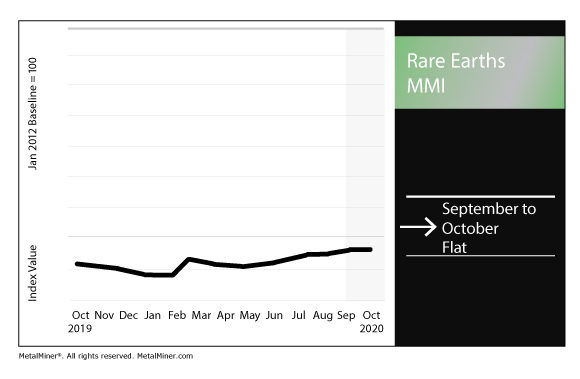Rare Earths MMI: Executive order takes aim at U.S. critical mineral import dependence
The Rare Earths Monthly Metals Index (MMI) posted no movement for this month’s index reading, as President Donald Trump signed an executive order that aims to strengthen the domestic mining industry and mitigate dependence on foreign sources of critical minerals.
Sign up today for Gunpowder, MetalMiner’s free, biweekly e-newsletter featuring news, analysis and more.
New executive order again takes aim at U.S. import dependence
Late last month, President Donald Trump issued an executive order that seeks to curb U.S. dependence on foreign sources of critical minerals.
Chief among those foreign sources is China, which controls an overwhelming majority of the world’s rare earths mining and processing.
“Our dependence on one country, the People’s Republic of China (China), for multiple critical minerals is particularly concerning,” the executive order reads. “The United States now imports 80 percent of its rare earth elements directly from China, with portions of the remainder indirectly sourced from China through other countries.”
The order calls for the U.S. to enhance its mining and processing capacity, including some minerals not identified as critical.
“By expanding and strengthening domestic mining and processing capacity today, we guard against the possibility of supply chain disruptions and future attempts by our adversaries or strategic competitors to harm our economy and military readiness,” the order continues.
Furthermore, the report calls for the Secretary of the Interior to consult with several other department heads. They will investigate the U.S.’s reliance on foreign sources for critical minerals. After the investigation, the Secretary of the Interior will submit a report to the president within 60 days.
The report, the order reads, will summarize the investigation’s conclusions and recommend executive action. Potential actions include tariffs, quotas and import restrictions against China and other “non-market foreign adversaries.”
Lynas releases annual report
Aside from the executive order, Australia’s Lynas Corporation, the world’s second-largest rare earths producer and the largest outside of China, recently released its annual report.
“As a result of a number of years of prudent capital management, Lynas entered the COVID-19 pandemic in robust financial shape,” Lynas said. “In March 2020, the Lynas team moved quickly to implement recommended government safety and health recommendations and industry best practices across all sites and the company continues to update protocols in line with the evolving situation.”
Lynas recorded an EBITDA of $59.8 million for fiscal year 2020 (ending June 30, 2020). Meanwhile, it recorded an EBITDA of $100.7 million in fiscal year 2019.
The decline, Lynas said, is largely attributable to the six-week shutdown of its processing plant in Malaysia. Lynas shut down the plant as a result of the government’s COVD-19 Movement Control Order. As such, Lynas noted production halted during the period and sales from inventory were “limited.”
Furthermore, Lynas temporarily shut down its Mt. Weld operation from April 9-June 16 after acquisition of target inventory levels of concentrate stocks.
Actual metals prices and trends
The Chinese yttrium price rose 0.8% month over month to $33.10 per kilogram.
Meanwhile, terbium oxide fell 1.7% to $709.78 per kilogram.
Neodymium oxide dropped 2.3% to $51,633.52 per metric ton. Europium oxide fell 3.9% to $30.16 per kilogram.
Finally, Dysprosium oxide fell 4.9% to $247.13 per kilogram.
The MetalMiner 2021 Annual Outlook consolidates our 12-month view and provides buying organizations with a complete understanding of the fundamental factors driving prices and a detailed forecast that can be used when sourcing metals for 2021 — including expected average prices, support and resistance levels.



Leave a Reply